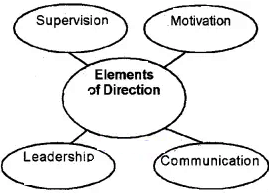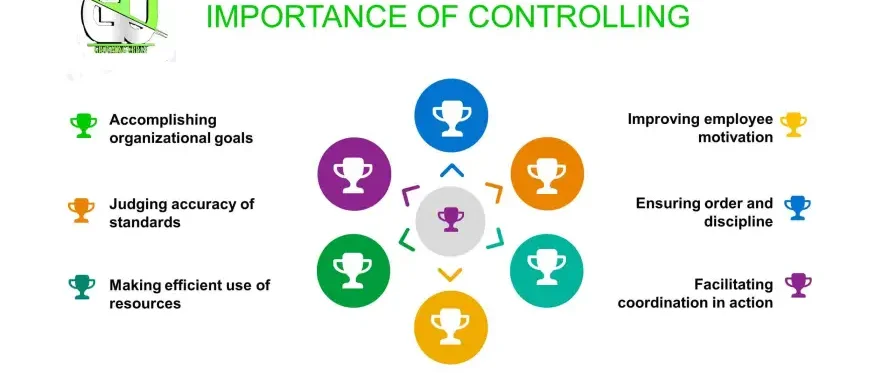Table of Contents
ToggleDirecting and Leading
Directing involves supervising or leading the workers to accomplish the goals of the organization.
Directing is the process of getting the organization’s work done.
Directing is a management function performed by top-level management to achieve the objectives of an organization. It is considered the life-spark of the organization because it sets in motion the actions of people.
Planning, organizing, and staffing are mere preparations for doing the work, and directing is the process of getting the work done.
In many organizations, directing involves marking assignments, assisting workers to carry out assignments, interpreting organizational policies and informing workers of how well they are performing. To effectively carry out this function, managers must have leadership skills which include; Effective communication, delegation, coaching, conflict resolution, motivation.

Importance of Directing
- Initiates action: Directing is the function that initiates action in a hospital. It is the process of setting goals, assigning tasks, and providing the necessary resources to employees so that they can begin working towards those goals.
- Creates a motivated workplace: A motivated workforce is essential for any organization, but it is especially important in a hospital, where the quality of patient care depends on the dedication and commitment of the staff. Directing can help to create a motivated workplace by providing employees with clear goals, providing them with the necessary resources to do their jobs effectively, and recognizing and rewarding their achievements.
- Provides guidance and instruction: Employees in a hospital need clear guidance and instruction in order to perform their jobs effectively. Directing provides this guidance and instruction by setting clear expectations, providing training and development opportunities, and providing feedback on performance.
- Ensures effective communication: Effective communication is essential for any organization, but it is especially important in a hospital, where the lives of patients may depend on the ability of staff to communicate effectively with each other. Directing can help to ensure effective communication by establishing clear lines of communication, promoting open and honest communication, and resolving conflicts.
- Coordinates activities: A hospital is a complex organization with many different departments and units. Directing helps to coordinate the activities of these different departments and units so that they are working together effectively towards the achievement of the hospital’s goals.
- Improves efficiency and productivity: Directing can help to improve efficiency and productivity in a hospital by ensuring that employees are working towards the same goals, that they have the necessary resources to do their jobs effectively, and that they are working together effectively.
- Creates a positive work environment: A positive work environment is essential for any organization, but it is especially important in a hospital, where the stress levels can be high. Directing can help to create a positive work environment by providing employees with clear goals, providing them with the necessary resources to do their jobs effectively, and recognizing and rewarding their achievements.
- Facilitates decision-making: Directing helps to facilitate decision-making in a hospital by providing employees with the information and support they need to make informed decisions. This can help to improve the quality of decision-making and lead to better outcomes for patients.
- Promotes teamwork and collaboration: Directing can help to promote teamwork and collaboration in a hospital by creating a culture of cooperation and mutual respect. This can help to improve the working relationships between employees and lead to better patient care.
- Enhances employee morale: Directing can help to enhance employee morale by providing employees with the recognition, support, and guidance they need to succeed. This can lead to increased job satisfaction and motivation, which can ultimately lead to better patient care.
- Contributes to the overall success of the hospital: Directing is an essential function of management in any organization, including hospitals. By providing guidance, motivation, and supervision to employees, directing helps to ensure that the hospital is operating efficiently and effectively and that patients are receiving the best possible care.

Process of Directing/Steps of Directing
1. Defining the objectives: The first step in directing is to define the objectives of the hospital. These objectives should be specific, measurable, achievable, relevant, and time-bound. For example, a hospital might have the following objectives:
- To provide high-quality patient care
- To improve patient satisfaction
- To reduce costs
- To increase efficiency
2. Organizing the effort: Once the objectives have been defined, the next step is to organize the effort to achieve them. This involves creating a structure of authority and responsibility, and assigning tasks to employees. For example, the hospital might create the following departments:
- Patient care department
- Finance department
- Human resources department
- Marketing department
3. Measuring work: The next step is to measure work to ensure that it is being performed according to the standards. This can be done through observation, reports, and other methods. For example, the hospital might measure the following:
- Patient satisfaction scores
- Employee turnover rates
- Financial performance
- Efficiency of operations
4. Developing people: The final step in directing is to develop people. This involves providing employees with the training and support they need to perform their jobs effectively. For example, the hospital might offer the following training programs:
- Patient care training
- Leadership training
- Management training

Elements of Directing
- Communication: The process of passing information, experience, opinions, etc., from one person to another. It is a bridge of understanding and involves the exchange of ideas and information to create mutual understanding. A manager must explain plans and orders to subordinates and understand their problems. Developing a sound two-way communication system is essential to stay in touch with subordinates. Sound communication fosters mutual understanding and coordination among different units of the organization.
- Leadership: The process by which a manager guides and influences the work of subordinates in the desired direction. Leadership involves integrating organizational interests with personal goals. An effective manager possesses the qualities of a good leader. Through leadership, a manager can build confidence and zeal among subordinates. To guide subordinates in the desired direction, a manager should adopt an appropriate style of leadership. The pattern and quality of leadership determine the level of motivation. Leadership is always related to a particular situation.
- Motivation: Inspiring, stimulating, or encouraging subordinates with zeal to work. Positive, negative, monetary, and non-monetary incentives may be used for this purpose. Motivation implies inspiring subordinates to work with zeal and confidence. No administrative action can succeed unless subordinates are motivated to contribute their best efforts to the common task. To activate and actuate subordinates to work in the desired manner, a manager must use appropriate incentives. Various financial and non-financial incentives are available to a manager for this purpose. Motivation is a continuous process of understanding and satisfying human needs.
- Supervision: Overseeing the work of subordinates by their superiors. It involves watching and directing work and workers to ensure that work is being done as planned. Every manager must supervise the work of subordinates to ensure they do their work as desired. Supervision is an important element of the directing process, particularly at the operating level of management. The supervisor is in direct personal contact with workers and acts as a link between workers and management. The supervisor communicates the policies, plans, and orders of management to the workers and brings workers’ grievances, suggestions, and appeals to the notice of management. Effective supervision is essential for accomplishing desired goals. The purpose of supervision is to ensure that subordinates perform their tasks according to prescribed procedures and as efficiently as possible.
Controlling
Controlling in management refers to monitoring activities to ensure that they are performed as planned and correcting any significant deviations.
Controlling is the final step in the management process. It involves measuring actual performance against standards and taking corrective action if necessary to ensure that the organization’s goals are achieved.

Importance of Controlling
1. Accomplishing organizational goals
In a hospital setting, directing is essential for accomplishing organizational goals, such as providing high-quality patient care, improving patient satisfaction, and increasing operational efficiency. Directors must communicate these goals to employees, motivate them to achieve these goals, and supervise their performance to ensure that they are working towards these goals.
2. Judging accuracy of standards
Directors must also ensure that the standards they set for employees are accurate and objective. For example, they must ensure that the standards for patient care are based on evidence-based practices and that the standards for employee performance are fair and achievable.
3. Making efficient use of resources
Hospitals have limited resources, so it is important for directors to make efficient use of these resources. Directing can help to ensure that resources are allocated to the most important areas and that they are used in the most effective way possible. For example, directors can use data to identify areas where costs can be reduced or where efficiency can be improved.
4. Improving employee motivation
Employee motivation is essential for high-quality patient care. Directors can use directing to motivate employees by communicating goals and expectations, providing recognition and rewards, and creating a positive work environment.
5. Ensuring order and discipline
Hospitals are complex organizations with many different departments and employees. Directing can help to ensure that there is order and discipline in the workplace. Directors can do this by setting clear rules and procedures, enforcing these rules and procedures, and taking disciplinary action when necessary.
6. Facilitating coordination in action
Directing can also help to facilitate coordination in action between different departments and employees. For example, directors can use meetings, emails, and other communication tools to ensure that everyone is on the same page and that they are working together towards the same goals.

Process of Controlling
- Establishing performance standards: The first step in controlling is to establish performance standards. These standards should be specific, measurable, achievable, relevant, and time-bound.
- Measuring actual performance: The next step is to measure actual performance. This can be done through observation, reports, and other methods.
- Comparing actual performance to standards: Once actual performance has been measured, it is compared to the performance standards. This comparison will reveal any deviations from the standards.
- Taking corrective action: If there are any deviations from the standards, corrective action must be taken. This may involve changing the work process, retraining employees, or taking other steps to improve performance.
Features of Controlling
- Controlling is a continuous process: Controlling is not a one-time event. It is an ongoing process that should be carried out regularly to ensure that the organization’s goals are being achieved.
- Controlling is forward-looking: Controlling is not just about looking at past performance. It is also about looking ahead and anticipating potential problems. This allows managers to take proactive steps to prevent problems from occurring.
- Controlling is pervasive: Controlling is not just the responsibility of top management. It is the responsibility of all managers at all levels of the organization.
- Controlling is related to planning: Controlling is closely related to planning. The standards that are used to measure performance are derived from the organization’s plans.

Benefits of Controlling
Improved performance: Controlling helps to improve performance by identifying and correcting problems.
Increased efficiency: Controlling helps to increase efficiency by identifying and eliminating waste and duplication.
Reduced costs: Controlling helps to reduce costs by identifying and eliminating unnecessary expenses.
Improved customer satisfaction: Controlling helps to improve customer satisfaction by ensuring that products and services meet customer requirements.
Increased profitability: Controlling helps to increase profitability by improving performance, increasing efficiency, and reducing costs.


I love these notes
Thank you!
Quite good notes for. Us students
God should answer your all prayers, these notes are motivating me to revise the whole course outline
Pingback: Directing and Leadership in Nursing Management - NRNote
Comprehensive notes, I enjoy reading notes of HSM by nurses’ revision
It’s a great impact to the profession, keep it up.